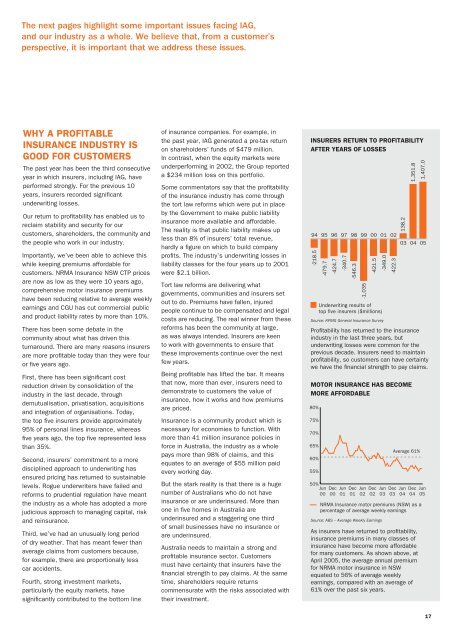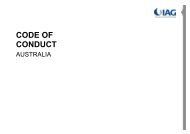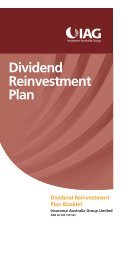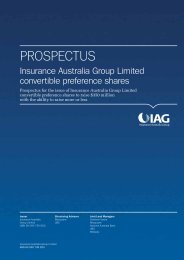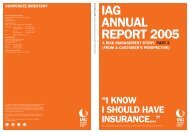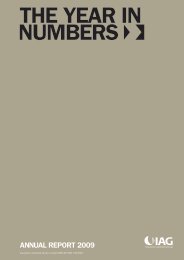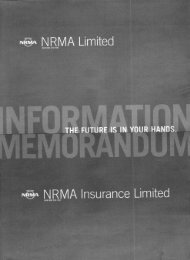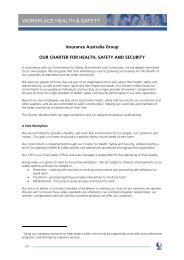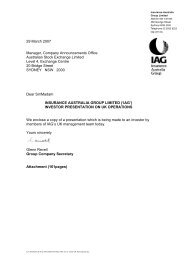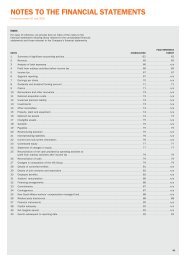IAG annual report—Concise
IAG annual report—Concise
IAG annual report—Concise
You also want an ePaper? Increase the reach of your titles
YUMPU automatically turns print PDFs into web optimized ePapers that Google loves.
The next pages highlight some important issues facing <strong>IAG</strong>,<br />
and our industry as a whole. We believe that, from a customer’s<br />
perspective, it is important that we address these issues.<br />
WHY A PROFITABLE<br />
INSURANCE INDUSTRY IS<br />
GOOD FOR CUSTOMERS<br />
The past year has been the third consecutive<br />
year in which insurers, including <strong>IAG</strong>, have<br />
performed strongly. For the previous 10<br />
years, insurers recorded significant<br />
underwriting losses.<br />
Our return to profitability has enabled us to<br />
reclaim stability and security for our<br />
customers, shareholders, the community and<br />
the people who work in our industry.<br />
Importantly, we’ve been able to achieve this<br />
while keeping premiums affordable for<br />
customers. NRMA Insurance NSW CTP prices<br />
are now as low as they were 10 years ago,<br />
comprehensive motor insurance premiums<br />
have been reducing relative to average weekly<br />
earnings and CGU has cut commercial public<br />
and product liability rates by more than 10%.<br />
There has been some debate in the<br />
community about what has driven this<br />
turnaround. There are many reasons insurers<br />
are more profitable today than they were four<br />
or five years ago.<br />
First, there has been significant cost<br />
reduction driven by consolidation of the<br />
industry in the last decade, through<br />
demutualisation, privatisation, acquisitions<br />
and integration of organisations. Today,<br />
the top five insurers provide approximately<br />
95% of personal lines insurance, whereas<br />
five years ago, the top five represented less<br />
than 35%.<br />
Second, insurers’ commitment to a more<br />
disciplined approach to underwriting has<br />
ensured pricing has returned to sustainable<br />
levels. Rogue underwriters have failed and<br />
reforms to prudential regulation have meant<br />
the industry as a whole has adopted a more<br />
judicious approach to managing capital, risk<br />
and reinsurance.<br />
Third, we’ve had an unusually long period<br />
of dry weather. That has meant fewer than<br />
average claims from customers because,<br />
for example, there are proportionally less<br />
car accidents.<br />
Fourth, strong investment markets,<br />
particularly the equity markets, have<br />
significantly contributed to the bottom line<br />
of insurance companies. For example, in<br />
the past year, <strong>IAG</strong> generated a pre-tax return<br />
on shareholders’ funds of $479 million.<br />
In contrast, when the equity markets were<br />
underperforming in 2002, the Group reported<br />
a $234 million loss on this portfolio.<br />
Some commentators say that the profitability<br />
of the insurance industry has come through<br />
the tort law reforms which were put in place<br />
by the Government to make public liability<br />
insurance more available and affordable.<br />
The reality is that public liability makes up<br />
less than 8% of insurers’ total revenue,<br />
hardly a figure on which to build company<br />
profits. The industry’s underwriting losses in<br />
liability classes for the four years up to 2001<br />
were $2.1 billion.<br />
Tort law reforms are delivering what<br />
governments, communities and insurers set<br />
out to do. Premiums have fallen, injured<br />
people continue to be compensated and legal<br />
costs are reducing. The real winner from these<br />
reforms has been the community at large,<br />
as was always intended. Insurers are keen<br />
to work with governments to ensure that<br />
these improvements continue over the next<br />
few years.<br />
Being profitable has lifted the bar. It means<br />
that now, more than ever, insurers need to<br />
demonstrate to customers the value of<br />
insurance, how it works and how premiums<br />
are priced.<br />
Insurance is a community product which is<br />
necessary for economies to function. With<br />
more than 41 million insurance policies in<br />
force in Australia, the industry as a whole<br />
pays more than 98% of claims, and this<br />
equates to an average of $55 million paid<br />
every working day.<br />
But the stark reality is that there is a huge<br />
number of Australians who do not have<br />
insurance or are underinsured. More than<br />
one in five homes in Australia are<br />
underinsured and a staggering one third<br />
of small businesses have no insurance or<br />
are underinsured.<br />
Australia needs to maintain a strong and<br />
profitable insurance sector. Customers<br />
must have certainty that insurers have the<br />
financial strength to pay claims. At the same<br />
time, shareholders require returns<br />
commensurate with the risks associated with<br />
their investment.<br />
INSURERS RETURN TO PROFITABILITY<br />
AFTER YEARS OF LOSSES<br />
<br />
<br />
MOTOR INSURANCE HAS BECOME<br />
MORE AFFORDABLE<br />
<br />
<br />
<br />
<br />
<br />
<br />
<br />
<br />
<br />
<br />
<br />
<br />
<br />
<br />
<br />
<br />
<br />
<br />
<br />
<br />
<br />
<br />
<br />
Source: KPMG General Insurance Survey<br />
Profitability has returned to the insurance<br />
industry in the last three years, but<br />
underwriting losses were common for the<br />
previous decade. Insurers need to maintain<br />
profitability, so customers can have certainty<br />
we have the financial strength to pay claims.<br />
<br />
<br />
<br />
<br />
Source: ABS – Average Weekly Earnings<br />
<br />
<br />
<br />
<br />
<br />
<br />
<br />
<br />
<br />
<br />
<br />
<br />
<br />
<br />
<br />
As insurers have returned to profitability,<br />
insurance premiums in many classes of<br />
insurance have become more affordable<br />
for many customers. As shown above, at<br />
April 2005, the average <strong>annual</strong> premium<br />
for NRMA motor insurance in NSW<br />
equated to 56% of average weekly<br />
earnings, compared with an average of<br />
61% over the past six years.<br />
<br />
<br />
<br />
<br />
17


